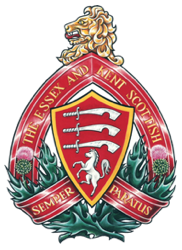Ceding of Michigan 1812

Paylist distributing loot and pay to soldiers who participated in the Battle of Detroit.
On 18 June 1812 a border dispute between the United States and Canada escalated into full-scale war. From 12 July to 7 August the US Northwest Army commanded by Brigadier-General William Hull occupied the Windsor area. Hull and his troops retreated back to the Michigan Territory after their supply train was captured by Indigenous warriors during a raid the week previous. By early August 1812, Colonel Henry Proctor had arrived in Fort Amherstburg and organized the British regulars, Canadian militia and Indigenous warriors. He was to see first-hand that desertion was disconcertingly common among militiamen in the district mostly over concern about food shortages in the area due to the burden of American occupation. Proctor decided that it was time to force an attack on Fort Detroit regardless of these anxieties.
Major-General Brock, Commander of Upper Canada military forces arrived on 14 August with more regulars and militiamen. The force now included 400 regulars from the 41st (Welch) Regiment of Foot, 1,360 militia of which 546 were from the Essex and Kent regiments. The rest were from other militia regiments. Brock organized part of them into three assault brigades that were led by Colonel Procter. Six hundred Indigenous warriors under Chief Tecumseh also joined the fighting force.
An artillery barrage began on 15 August, which inflicted minimal damage. While the barrage continued, Tecumseh and his warriors went across the Detroit River to capture the beach head near Spring Wells. The combined British and Indigenous forces marched up Hull’s Road to within a mile of Fort Detroit. The British in their uniforms looked like a formidable force while the Indigenous went in and out of the clearing to appear more numerous than they were. The Americans remained behind the fort walls and were not forced out by the artillery fire. Brock soon learned that 350 American soldiers were approaching his rear only a few miles away. Fearing an attack from the rear, this was enough incentive for Brock to assault Fort Detroit directly. Almost as soon as he ordered the attack, a white flag was raised in surrender. By surrendering, Hull gave up the Northwest Army and, by extension, control over Fort Detroit and the other American outposts in the area such as Wayne and Frenchtown. The American militiamen were released from duty on parole, while their regular soldiers were sent to Quebec City as prisoners of war.
Upon taking the territory, Brock stated that Michigan belonged to Britain even though neither government were involved in the decision of the decision. Assuming approval as a given, he instated Procter as Civil Governor. Procter planned to relocate thousands of Indigenous people into the Detroit River lands and take away land grants from American citizens if they did not swear fealty to King George III. He also established the legislative, judicial, and executive arms of the Michigan government.
General Brock had promised the Indigenous groups that had aided the British that he would take their land back from the Americans, and the cession of Michigan was the first stage of that plan. It also coincides with Procter’s plan to redraw the boundary between Upper Canada and the United States so that the line fell below Lake Erie over to the Mississippi River. Brock also convinced the British government to present Indigenous demands as part of the negotiation process when the peace treaty was eventually established.
Brock installed members of the Essex and Kent regiments in an honour guard that occupied Fort Detroit as thanks to the men for their efforts in taking the American territory. A third of the men in the Detroit offensive were from the 1st and 2nd Regiments of Essex Militia and the Kent Regiment of Militia, but only Colonel Matthew Elliott of the 1st Regiment was initially nominated for the General Service Medal that was created to honour actions in the War of 1812. Later, other members of the militia would be recognized for their service. This increased the total amount of medal recipients from the regiments to forty-nine. The medals given to the men of the Essex and Kent militias made up nearly twenty percent of the 260 medals granted during the entire war.
The taking of Michigan also ensured a greater supply of ammunition and small arms for the militia. Captured artillery would be useful as the war progressed. Upper Canada then had a better sense of their own strength and pride in their ability to defend themselves. The ceding of Michigan Territory sparked a succession of armed conflicts led by the American army to take this land back which they did later in 1813.
Story by Nicole Pillon, Canada Summer Jobs 2022 participant
with The Essex and Kent Scottish Regiment Association
Sources
- Duty Nobly Done: The Official History of the Essex and Kent Scottish Regiment by Sandy Antal and Kevin R. Shackleton, 2006: Chapter 2
